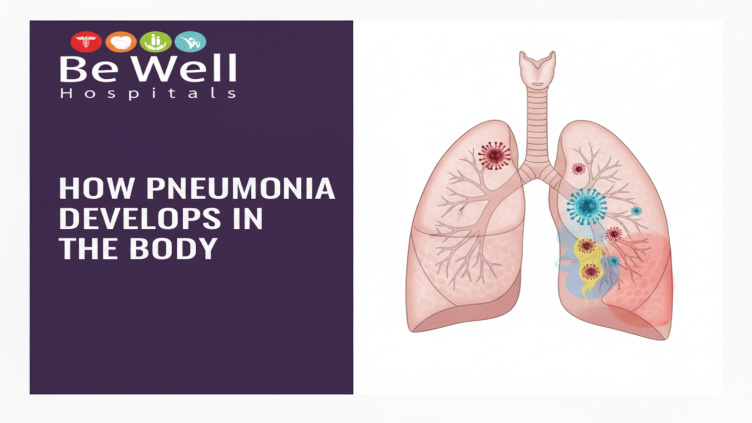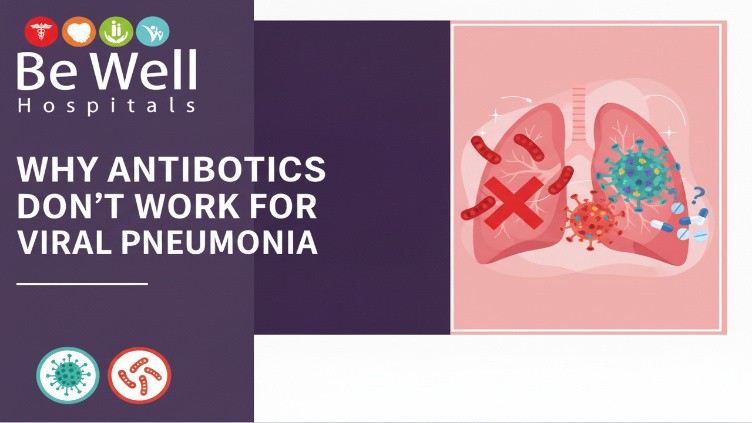
Introduction
Pneumonia is a serious infection that inflames the air sacs in one or both lungs, often filling them with fluid or pus and making it difficult for oxygen to pass into the bloodstream. This leads to coughing, fever, chills, and shortness of breath, which can range from mild discomfort to life-threatening complications. The infection directly affects how efficiently the lungs function—when the alveoli, or tiny air sacs, are clogged with mucus or fluid, the body struggles to get enough oxygen, leading to fatigue and, in severe cases, respiratory distress.
The Main Difference: Virus vs. Bacteria
Pneumonia can be caused by both viruses and bacteria, and understanding the difference is essential for proper diagnosis and treatment. Viral pneumonia usually develops after respiratory infections such as influenza or COVID-19, progressing gradually and often not responding to antibiotics. Bacterial pneumonia, on the other hand, can occur suddenly after exposure to specific bacteria—most commonly Streptococcus pneumoniae—and requires antibiotic therapy for recovery. While both forms inflame the lungs, their causes, symptoms, and treatment plans differ significantly. Knowing whether the infection is viral or bacterial helps doctors tailor the right treatment and avoid unnecessary antibiotic use.
What Causes Viral Pneumonia
Viral pneumonia occurs when viruses infect the respiratory system and spread into the lungs. Common culprits include influenza virus, respiratory syncytial virus (RSV), adenovirus, and coronaviruses such as SARS-CoV-2. These viruses attack the lining of the airways and alveoli, causing inflammation and fluid accumulation. As the body’s immune system fights back, the inflammation can intensify, leading to cough, fever, and breathing difficulties. Viral pneumonia often starts as a mild cold or flu that gradually worsens. While many cases are mild, it can become severe in infants, older adults, and those with weakened immunity.
What Causes Bacterial Pneumonia
Bacterial pneumonia develops when harmful bacteria invade the lungs—often after a viral infection or when the immune system is weakened. The most common cause is Streptococcus pneumoniae, though Haemophilus influenzae and Staphylococcus aureus can also trigger it. Once inside, bacteria multiply rapidly, causing inflammation that fills the air sacs with pus and fluid. Symptoms tend to appear suddenly and may include high fever, chest pain, and a productive cough with yellow or green mucus. Without timely antibiotic treatment, bacterial pneumonia can escalate quickly and lead to serious complications.
How Pneumonia Develops in the Body

Both viral and bacterial pneumonia begin when pathogens enter the lungs through inhaled air or migrate from the upper respiratory tract. In viral infections, viruses damage the lining of the airways, causing fluid leakage and reduced oxygen exchange. In bacterial infections, bacteria grow within the alveoli, triggering the immune system to release white blood cells that fight infection but also cause pus and inflammation. This immune response, though protective, can make breathing painful and labored.
Symptoms: How They Differ and Overlap
The symptoms of viral and bacterial pneumonia often overlap, making it difficult to distinguish between them without medical evaluation. Common symptoms include cough, fever, shortness of breath, chest pain, fatigue, and headache. However, bacterial pneumonia usually has a sudden onset with high fever and thick, discolored sputum, while viral pneumonia progresses gradually with milder symptoms, a dry cough, and fatigue following a cold or flu. Recognizing these subtle differences and seeking timely medical care can prevent complications and ensure faster recovery.
When Symptoms Worsen
If pneumonia symptoms intensify—such as rising fever, worsening cough, shortness of breath, or bluish lips—it’s a warning sign that the infection may be spreading. Immediate medical attention is crucial, as untreated pneumonia can lead to complications like respiratory failure or sepsis. Avoid self-medication, since improper or delayed treatment can worsen the condition. Early diagnosis and prompt care are key to a smooth and complete recovery.
Diagnosis: How Doctors Identify the Cause
Doctors diagnose pneumonia by evaluating symptoms, listening to chest sounds for crackles or wheezing, and ordering diagnostic tests such as chest X-rays and blood tests. A sudden high fever and productive cough often suggest bacterial pneumonia, while gradual symptoms with a dry cough point toward a viral cause. Sputum cultures and nasal swabs help identify the exact pathogen, while PCR or antigen tests confirm viral infections like influenza or COVID-19. Accurate diagnosis ensures patients receive the right treatment—antibiotics for bacterial infections and supportive or antiviral care for viral cases.
Treatment and Recovery
Bacterial pneumonia is treated with antibiotics that target the infection-causing bacteria. Symptoms often begin improving within a few days of medication, though fatigue and cough may linger. Viral pneumonia, in contrast, does not respond to antibiotics and is usually managed with rest, fluids, and medicines to reduce fever and pain. In some cases—especially influenza-related pneumonia—antiviral drugs may be prescribed. Regardless of the cause, supportive care such as oxygen therapy, hydration, and adequate nutrition plays a vital role in recovery.
Why Antibiotics Don’t Work for Viral Pneumonia

Antibiotics are designed to kill bacteria, not viruses. Using them unnecessarily for viral infections not only fails to cure the illness but can also contribute to antibiotic resistance, making future bacterial infections harder to treat. That’s why understanding the cause of pneumonia is so important. For viral pneumonia, supportive care and the body’s natural immune response are the best paths to recovery.
Recovery and Possible Complications
Recovery time varies depending on the cause and the patient’s health. Mild cases often resolve within one to three weeks, but more severe infections can take longer. Weak immunity or delayed treatment increases the risk of complications like pleural effusion (fluid buildup around the lungs), lung abscess, or sepsis. Elderly individuals and those with chronic conditions like diabetes or heart disease are especially vulnerable. Regular follow-ups, chest X-rays, and good nutrition are essential to ensure full recovery and prevent long-term damage.
Who’s Most at Risk
Certain groups are more prone to developing pneumonia or facing severe complications:
- Infants and young children with developing immune systems
- Adults over 65 years of age
- People with chronic illnesses such as asthma, diabetes, or heart disease
- Individuals with weakened immunity due to chemotherapy, HIV, or long-term steroid use
- Smokers and heavy alcohol users
- Hospitalized or ventilated patients
- Those exposed to air pollution, dust, or industrial fumes
Recognizing these risks helps with early prevention and timely medical care.
Prevention: Reducing the Risk
Preventing pneumonia is often easier than treating it. Vaccines such as pneumococcal, flu, and COVID-19 vaccines offer strong protection against common causes. Practicing good hygiene—washing hands, covering your mouth when coughing, and avoiding close contact with sick individuals—also helps reduce spread. Maintaining a healthy immune system through proper nutrition, exercise, and quitting smoking further strengthens the body’s defenses. For children, the elderly, and people with chronic conditions, regular check-ups and timely vaccinations are vital.
Conclusion
Pneumonia remains a common yet preventable respiratory illness that can turn serious without proper care. Understanding the difference between viral and bacterial causes, recognizing early symptoms, and getting timely medical attention are the keys to preventing complications and ensuring recovery. Simple habits such as vaccination, maintaining hygiene, and strengthening immunity can go a long way in keeping your lungs healthy. If you or someone you know experiences persistent cough, fever, or breathing difficulty, don’t delay care—your lungs deserve prompt attention. For expert evaluation and treatment from our Pulmonology specialists, visit Be Well Hospitals or call 9698 300 300 to book an appointment and take a confident step toward better respiratory health.
